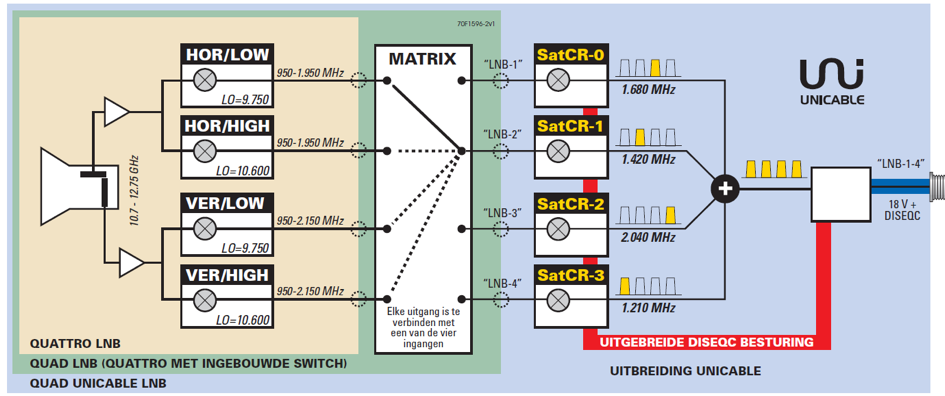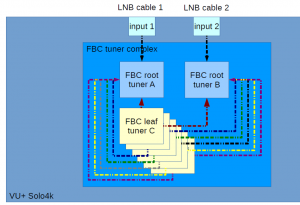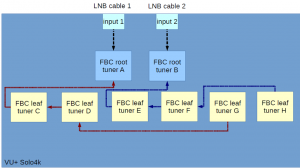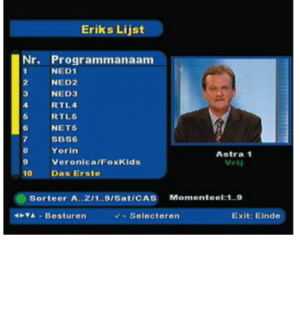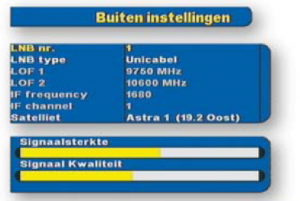Difference between revisions of "Unicable / Jess"
Rick Hunter (talk | contribs) |
Rick Hunter (talk | contribs) |
||
| Line 8: | Line 8: | ||
For users that have installed Unicable equipment, unfortunately, they will need to reconfigure their tuners. That’s due to tuner configuration having changed. It’s more logical and simpler now. In the process, we added a pile of preconfigured Unicable and JESS switches, so most users will not have to enter all user bands separately; they can now just choose the appropriate switch model.<br /> | For users that have installed Unicable equipment, unfortunately, they will need to reconfigure their tuners. That’s due to tuner configuration having changed. It’s more logical and simpler now. In the process, we added a pile of preconfigured Unicable and JESS switches, so most users will not have to enter all user bands separately; they can now just choose the appropriate switch model.<br /> | ||
| + | |||
'''Why it's called Jess and not 'Unicable 2'?'''<br /> | '''Why it's called Jess and not 'Unicable 2'?'''<br /> | ||
| Line 14: | Line 15: | ||
[[File:Unicable-Jess-005.png]]<br /> | [[File:Unicable-Jess-005.png]]<br /> | ||
| − | Our developer Erik explains: | + | ''Our developer Erik explains:'' |
Erik: “First a few concepts: SCR (Unicable / JESS) and FBC. SCR is separate from FBC. If you would have a receiver with eight loose tuners (if it were to exist) then you could use SCR exactly as with an FBC tuner. If you use a FBC tuner for SCR (= Single Cable Reception), it's no more and no less than eight sounded tuners. | Erik: “First a few concepts: SCR (Unicable / JESS) and FBC. SCR is separate from FBC. If you would have a receiver with eight loose tuners (if it were to exist) then you could use SCR exactly as with an FBC tuner. If you use a FBC tuner for SCR (= Single Cable Reception), it's no more and no less than eight sounded tuners. | ||
Revision as of 21:48, 1 June 2017
Source: UP/DOWNLINK, jaargang 2016, nummer 12.
Translation and updating in Progress..
Since december 12th 2016 OpenPLi is supporting Jess.
See: https://forums.openpli.org/topic/46048-announcement-jess-support/
For those not familiar with JESS, it’s a system comparable to Unicable, but with extended capabilities (more positions, more user bands).
Users not employing Unicable or JESS equipment will experience no difference.
For users that have installed Unicable equipment, unfortunately, they will need to reconfigure their tuners. That’s due to tuner configuration having changed. It’s more logical and simpler now. In the process, we added a pile of preconfigured Unicable and JESS switches, so most users will not have to enter all user bands separately; they can now just choose the appropriate switch model.
Why it's called Jess and not 'Unicable 2'?
Jultec has developed this protocol, so they have every right to call it "JESS". Then they had it standardized by CENELEC as an EN... standard (which name nobody uses because it's far too long). Also Jultec never called it "Unicable 2", that's an invention of outsiders. As previously correctly stated, the term "Unicable II" is not officially linked to the EN50607 European standard, but actually also Jultec recognizes that some manufacturers use different naming for this standard like "Unicable 2":
Our developer Erik explains:
Erik: “First a few concepts: SCR (Unicable / JESS) and FBC. SCR is separate from FBC. If you would have a receiver with eight loose tuners (if it were to exist) then you could use SCR exactly as with an FBC tuner. If you use a FBC tuner for SCR (= Single Cable Reception), it's no more and no less than eight sounded tuners. Where a FBC tuner is just a bit different from a few loose tuners, if you're NOT a SCR tuner. The first two tuners (A and B) are EXACT equal to an ordinary tuner. You can connect whatever you want, a single LNB, a simple switch, a multiswitch, a rotor, whatever you want. See the following schedules.
The other six tuners (C to H) are just a bit different. These tuners do not have their own physical connection with a cable (LNB input). Again the analogy with a receiver with eight loose tuners; You must imagine that you have listened to the first two tuners with their own cable and the other six tuners. That's the principle of an FBC tuner.
There is a difference. If you usually pass loose tuners, choose to loosen it to one particular other tuner. The sounded tuner is thus "fixed" on a particular cable. FBC tuners can "dynamically loop through". Once you have not connected 1 but 2 cables, Enigma searches for any channel you choose from which cable the first available tuner should be. In the tuner setup screen you can see what's up to date at any time. So you do not have to do that by yourself, Enigma does it for you.
Practical example. Imagine having two quattro LNBs on the famous 23.5E and 28.2E with a multiswitch on the back. In addition, I have some LNBs for less viewed positions. They then appear on an uncommitted switch. So you have two cables in this way; On one cable you can watch 23.5E and 28.2E, while the other cables enter the other positions.
What you do then connect both cables to the FBC. Tuner A configures you as DiSEqC 4 positions (with 2 configured, in this case), Tuner B configures you as advanced, DiSEqC 1.1, uncommitted command = input 1,2,3, etc. You can then select the 23.5E and 28.2E Tuner A and other positions on tuner B. Enigma automatically ensures that the correct tuner is selected.
If you are going to watch more than one transponder at either 23.5E and 28.2E or in other positions, you would normally be notified by Enigma that it is not possible, all tuners are in use.
Now with the FBC tuner, he will see what the next unused tuner is. This is usually C, but if you are well busy, that may be H, for example. Then he will look what input you need, 23.5E and 28.2E or the other positions. Then check which tuner is connected (A or B). At that time, Enigma internally makes a new loop of the new tuner to tuner A or tuner B, depending on what is needed. If you leave that transponder, that loopback will be undone again.
So, eight tuners in total, two physically just like any other tuner, six without physical input, but dynamically transmitted to tuner A or B, which has a physical connection. And then the normal limitation of loop loops also applies, only transponders in the same quadrant can be shared over the same cable. Tuner A and B, which have the physical connection, give the commands to the switch or LNB and thus determine low / high and vertical / horizontal. The passers-byers (C-H) can only compete with them; If the tire (low / high) and polarization (vertical / horizontal) are equal, no commands need to be sent and tuner A or B can just keep doing what it's doing and it's no problem. If the tire or polarization is different then it is not possible to loosen.
The good news is that all CanalDigitaal transponders on Astra 23.5 oz have the same band and polarization, so it's interesting for us. You can then provide all eight tuners with a single cable and can all work simultaneously. That means that only for Dutch channels, as soon as you have to go to another location (Astra 19.2 east) or another provider on Astra 23.5 east, this does not stop. Then only SCR (Unicable or JESS) helps.
About SCR
SCR is a system in itself, it is not an LNB (or a switch). From SCR you have two types, "Unicable" or "Unicable 1" and the newer "JESS" which is also called "Unicable 2". The idea is the same, the possibilities are different. The basics: You connect multiple tuners to one cable (hence the name). Each tuner is assigned a certain frequency (the "userband": UB). The tuner indicates the "outdoor" Unit "(ODU, which can be an LNB or a switch, usually switch) by which frequency it wants to receive, including polarity. The ODU then ensures that that particular frequency is transmitted to the frequency reserved for that tuner (UB ). The tuner is always always on the same frequency, the UB for that tuner, the ODU causes the desired frequency to end.
Depending on the ODU, you can use two to 8 (Unicable) or 32 (JESS) UBs, which is equal to the number of tuners you can connect. These tuners all work independently because there is no complete quart band over the cable (vertical / horizontal, high / low). That means you can "unleash" the tuners of one or more recipients without the usual disadvantages. FBC is no exception to this, an FBC tuner just counts as a string of tuned tuners. But because of the SCR concept, you can receive independent frequencies. And as I said, if you had a receiver with eight loose tuners (if it were to exist), that would be exactly the same.
Unicable was designed by Inverto at the time, and it still complies if you want to pass up to 2 positions and up to 8 user bands over the cable. If you want more placements or more user bands, you will come to JESS, which was later devised by Jultec.
I have experience with Unicable and JESS switches and that works very well, I can recommend it. You connect to regular quattro LNBs, just like on a regular multiswitch, only 4/6/8/10/12 / etc cables will only be one (sometimes two or more). There are also special SCR LNBs, with the LNB's running through without a switch. This way is cheaper than with a SCR switch, but it also gives limitations, I do not have any experience in any case.
You can buy an unicable switch for an amount of about one hundred euros. JESS switches are even more expensive, but the expectation is that it will be cheaper. There are JESS LNBs, which you can get from thirty euros."
